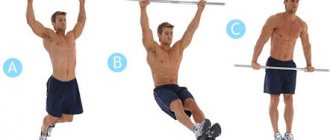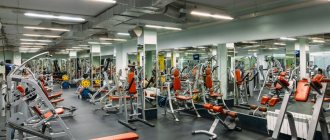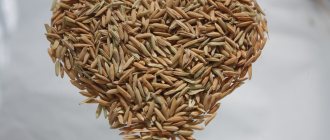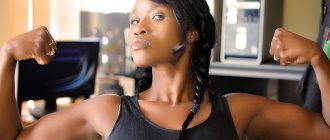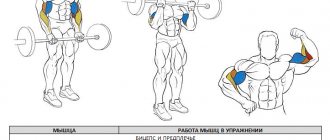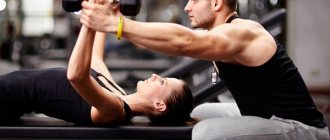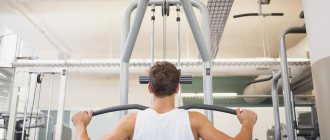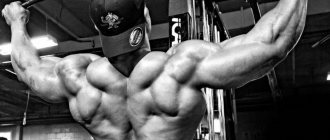Not only does a toned back look amazing, it helps the athlete achieve his goal, makes everyday life much easier, protects the spine and improves posture!
Knowing how to pump up your back is the sacred duty of every athlete and athlete, regardless of the type of sport: pumped up back muscles are equally necessary for powerlifters, swimmers, martial artists and especially bodybuilders.
There's nothing more stunning than well-developed back muscles that curve like roads on a map: broad dorsals like jet wings and lower back muscles.
Who needs to pump up their back muscles?
Back training is important for many reasons: pumped up back muscles will immediately make you stand out from the crowd of athletes, because only a real bodybuilder can work out the “wings”. Your body will look harmonious and balanced.
There is nothing you can do in martial arts without a strong back: your stabilization depends on the strength of your muscle corset. The back is the frame that holds all the muscles and unites the efforts of the whole body. Weak back muscles cannot properly perform their stabilizing role, and problems may arise in maintaining an upright posture. In wrestling, pumped-up back muscles make it easier to perform throws with body extension.
Powerlifters also strive to effectively pump up their backs: in powerlifting, this is the key to success in performing deadlifts, one of the competitive disciplines of powerlifting.
Why is it not easy to work out your back?
In addition, by pumping up your back muscles, you will significantly make your daily life easier, because we perform most of the functional movements, for example, carrying heavy objects, on our backs.
From a medical point of view, developed back and core muscles help maintain correct posture and spinal alignment, which has a positive effect on the vital organs of the abdominal cavity. You see how important it is to train your back, are you ready to train?
If you are already in the gym and ready to start, we recommend 2 programs from our training videos. Further in the article you will find several more program options.
The first training option is about how to pump up your back. In this video you will learn how to pump up your back, what exercises to do to pump up your latissimus dorsi muscles. Perform these exercises in three sets of eight repetitions each.
- Lying latissimus dorsi stretch
- Chest row on the upper block 3x8
- Pull-ups with deviation 3x8
- Reverse grip lat pulldown 3x8
- Wide-grip lat pulldown 3x8
In the next video you will learn the second training option for the back muscles.
You will understand the maximum understanding of what works for you and your body in pumping your back in the gym only after you start trying different exercises.
- Lower back stretch with lunge and twist 2x5
- Standing mid-back stretch (with body rotation) 2x5
- Rows to the waist on the simulator in support 3x8
- Pullover on a 3x8 block
- Bent-over barbell row 3x8
- Shrugs with dumbbells 3x8
The importance of back training
However, many people ignore the importance of this muscle group. The main reason for this is complexity, because it is quite difficult to feel how the back muscles work. The secret is to start all exercises using not only your arms, but also your back muscles.
How to pump your back if you still have problems? Use special hooks for lifting. This will reduce the stress on your biceps, putting more pressure on your back.
Note that this is about using enough weight, not too much. Train hard, but not so hard that you cheat to lift the barbell up, which is guaranteed to disable the muscles from the movement.
Another reason for a weak back is that people simply train with insufficient weight. If you need to make your muscles more massive, use more weight in your “pulling” exercises.
If you really want to pump up a wide back, do a good job of deadlifting.
We pump our back at home
We figured out the question: why pump your back. However, the question: how to properly pump your back at home yourself remains open (what exercises will be effective?). There is a lot of material on this topic on the Internet. However, the back (in particular the spine) is a very important and fragile part of the body, so we have collected only the most proven exercises. So, how to properly train your back muscles at home?
Arm rotation from plank position
Stand in a plank position, but instead of elbows, rest on your palms. Spread your legs slightly to the sides, tighten your lower back and abs to a slight tension. The palm is lifted off the floor, then a circular motion is performed.
Using the plank, we work the lower back, mid-back, abs, and latissimus dorsi muscles in the area of the shoulder blades.
Quantity:
10-15 reps, 2-3 sets per arm.
Swimmer exercise
The swimmer exercise helps to strengthen your back muscles at home without additional equipment. Lie on your stomach, stretch your arms out in front of you, palms down. Then lift your face and upper back off the floor. We pump up the upper back by simultaneously lifting the back and legs as high as possible. Quantity:
10-15 reps, 4-5 sets.
Strengthen your back with push-ups
Lying push-ups are the most popular exercise without sports equipment, allowing you to pump up your back muscles at home. Good for strengthening the spine. Works your back and chest at the same time. Often, the trainer advises girls to train their backs with push-ups.
During the exercise, the abdominal muscles tense, which leads to tension in the back. Thus, it works well on the lower back. Also, the latissimus dorsi muscles are worked at home without additional equipment. Back push-ups, like other muscles, can be trained quickly.
Place your palms on the floor, bring your legs together and stretch them back. Bend your elbows and lower yourself until your elbows are bent at a 90-degree angle. Then, straighten your arms. By performing this exercise regularly, you will quickly pump up your back with push-ups.
Quantity:
10-15 reps, 3-4 sets.
Human back: anatomy
Knowing muscle function is critical when designing a workout and understanding proper technique. With that in mind, let's take a look at the anatomy of the back:
Trapezius muscle
It is a very wide, triangular-shaped muscle that covers almost all the muscles in the back of the neck and large part of the back. It originates in the occipital bone at the base of the skull and enters the shoulder blades and collarbones. The fibers of this muscle ensure its stretching in three directions: up, down and inward. The functions of the trapezius muscle are to turn the head and raise the shoulders.
Many people work the trapezius muscle along with the shoulders, and this is a great method, however, in this article we will include the trapezius muscles in the back.
<Rhomboid minor/major muscles
The rhomboid muscles begin on the spine and attach to the middle of the shoulder blades. Their function is to bring the shoulder blades towards the spine.
Teres major muscle
This muscle originates on the outer edge of the scapula and attaches to the humerus. Its function is to stretch the arm back.
Latissimus dorsi muscles
These are the largest muscles of the back. Large, V-shaped and pumped, they provide back strength. The latissimus muscle attaches to the upper end of the humerus and runs down the spine and pelvic girdle. The function is to pull the arm down, and, if the arm is in a fixed position, to help pull the arms up.
Erector back muscles
The main function of these muscles is to support and stretch the spine. This group includes the following muscles: longissimus, spinalis and iliocostalis.
As you can see, working the back muscles, the anatomy of which has so many nuances, is quite difficult. However, there are two main types of movements that help tone your back: rowing movements and downward movements.
In addition, there are strength training movements such as deadlifts, snatches, and power cleans. These exercises work much more than just your back - thanks to them, you involve and pump up your whole body! These compound movements cause a dramatic natural increase in the amount of anabolic hormones in the body such as testosterone and growth hormone.
How to properly pump up your back
Although many people train their chest and back on the same day—by the way, Arnold did just that—it makes sense to train your back on a strictly designated day. It is especially worth paying attention to this method for those whose back is a weak point.
Then, if you want, you can train your biceps and develop your forearms. This will allow you to focus all your energy on working your back instead of “sharing” energy with the other large pectoral muscle group. Since the biceps are actively involved in all back exercises, it makes sense to train them after the back. It's a good idea to include forearms in this workout,
However, there is a theory that the forearms, like the abdominal muscles, need to be worked more often than others. These muscles have high endurance and are involved in every exercise performed (after all, you need a grip to hold the barbell), so work them hard no more than once a week along with your biceps.
The main thing is that you feel how the training works for you. Before going to the gym again, just make sure your muscles are fully recovered. Remember, growth only happens if you have enough recovery, not because of how many hours you spend in the gym every day.
Rules for working with back muscles
Many guys are interested in how to properly pump their back in order to quickly achieve results. There is no need to live in dreams, since pumping up muscles is not easy and this task will take several months.
To train your back, you need to rely on the rules of hypertrophy for muscle growth. To learn how to perform at least a few exercises correctly at first, we recommend contacting a fitness club trainer. Once you have mastered them, you can increase the load every day, paying attention to the technical execution of the exercises.
The best results for your back will come from training 2-3 times a week. During classes, you should combine exercises on the back, lower back, shoulders, and chest. Experienced athletes work out the triceps and biceps along with their back.
Back muscle workout #1
Deadlift
- 5 sets of 15,12,10,8,6 repetitions
- Body part: Quadriceps Equipment: Barbell
Pull-ups
- 1 set of 25 reps
- Body Part: Lat Equipment: Bodyweight
Note: If you can do that many pull-ups in one set, do two sets of 25 reps. Use a wide overhand grip and full range of motion
Bent-over barbell row
- 3 sets of 12 reps
- Body Part: Press Equipment: Barbell
Note: Use a weight that you can lift for 8 reps. Rest and then complete the set.
Add to Calendar * Add to My Workouts * Print Workout
* — The service is in beta testing
To properly tone your back muscles with this workout, remember this: your deadlift should be sharp and active, but completely controlled, and slow on the downward movement. Use a full range of motion when doing pull-ups, concentrating only on your back and not your biceps. Remember that your biceps are just hooks, nothing more.
Effective exercises to pump up back muscles in the gym for men
Undoubtedly, it is much easier to pump up your back muscles in the gym than at home. However, this training has its own nuances. The primary thing here is strict adherence to the exercise technique, which will reduce the risk of injury and micro-strains.
Pumping up your back in the gym: comprehensive training
| Exercises | Sets | Repetitions/Time |
| Barbell deadlift | 4 | 10-12 |
| Block pull to the chest | 4 | 10-15 |
| T-bar row | 4 | 10-12 |
| Barbell row on the Smith machine | 3-4 | 8-12 |
Classes in the gym necessarily include a constant progression of the load in the form of an increase in the weight with which the athlete works.
Deadlift
Read: Complex: healthy spine and lower back
Performance:
- The barbell should be taken with an overhand grip. The back is straight.
- Squat down deeply. Try to move your pelvis back. Push your feet off the floor. Get up. Feel the muscle tension.
- Slowly return to the starting position. The bar should touch the floor.
Deadlift
Block pull to the chest
Technique:
- Sit on the exercise bench. Grasp the handles with a narrow grip. The legs must be bent at the knee joints. Lower your straightened back slightly.
- Pull the block to your chest. Avoid rocking. Hold the position for two seconds.
- Extend your arms until they are completely straight.
T-bar row
Read: How to do the “Boat” exercise on your back at home
Performance:
- Load the bar. Stand up. Place the barbell between your legs. Grasp the bar. Tilt your body at a 45 degree angle. Keep your back straight. Knees slightly bent.
- Pull the bar toward your sternum. Hold at the top for a second.
- Smoothly lower the bar to its original place.
T-bar row
Barbell row on the Smith machine
Men are recommended to work with a barbell weighing 30 kilograms. Number of repetitions
- 10 times in 4 sets.
The video shows a version of the barbell row in a standing position
Performance:
- Get on the machine. Take the bar with a reverse grip. Adjust the machine so that in the starting position the bar is slightly below your knees. Legs are slightly bent.
- Exhale. Pull the barbell towards you by bending your arms. At the top of the exercise, hold for a couple of seconds. The body is motionless.
- Breathe in. Lower the bar.
Barbell row on the Smith machine
Three main muscle groups:
- The latissimus muscles are the most important. They shape the silhouette, visually making the shoulders wider.
- The trapezius muscles are the upper part of the back.
- The lower back can provide security to your spine. Protects against many diseases: osteochondrosis, pinched nerves.
Read: How to do close-grip barbell rows for the upper back
Classification of exercises for pumping up the back:
- Basic. Distributes tension to almost all muscles of the body. These include pull-ups, deadlifts, vertical block rows with various grips, and T-bar rows.
- Insulating. Additional muscles are turned off from work. The load falls exclusively on the back muscles. This type of exercise includes hyperextensions and weighted shoulder raises.
Back muscle training No. 2
Deadlift in a power rack
- 5 sets of 15,12,10,8,6 repetitions
- Body part: Lower back Equipment: Barbell
Smith Machine Bent Over Row
- 3 sets of 8 reps
- Body part: Middle back Equipment: Exercise
Pull-ups
- 4 sets of 10 reps
- Body Part: Lat Equipment: Bodyweight
Attention: 2 of these approaches are with a medium wide grip on top, and 2 with a wide grip
Shrugs with a barbell
- 4 sets of 12,10,8,6 repetitions
- Body part: Trapeze Equipment: Barbell
Note: All are working, so use a weight that will allow you to complete the required number of repetitions.
Add to Calendar * Add to My Workouts * Print Workout
* — The service is in beta testing
Power cleans are a sharp exercise. Be sure you understand this feature of the exercise and always keep your reps under control. The cable row should be performed with continuous tension: contract the muscles and count to 3 as you lower the weight to your chest. If possible, reverse the movement, counting to 4.
Use the same repetition method during lat pulldowns. When performing shrugs, pull your shoulders up towards your ears, hold and contract the muscles, work this way in any strength training in the gym, not just when pumping up the back muscles.
Workout for the broad back muscles No. 3
Pull-ups
- 1 set of 30 reps
- Body Part: Lat Equipment: Bodyweight
Note: 30 reps for as many sets as needed. If you can do that many pull-ups in one set, do two sets of 30 reps. Use a wide overhand grip and full range of motion
Pull-down of the upper block behind the head
- 2 sets of 8 reps
- Body part: Lat Equipment: Block
Smith Machine Bent Over Row
- 3 sets of 12 reps
- Body part: Middle back Equipment: Exercise
Standing dumbbell shrugs
- 4 sets of 12,10,10,8 repetitions
- Body part: Trapeze Equipment: Dumbbells
Add to Calendar * Add to My Workouts * Print Workout
* — The service is in beta testing
As you deadlift, pull the barbell toward your upper chest. In this and the next exercise, maintain continuous tension for the best back training. Pause and contract the muscles at the peak of the movement, counting to 3. When doing the T-bar row, move up sharply, move down slowly and in a controlled manner.
We pump our backs - what is important for a beginner to know?
First of all, when training the back, a beginner needs to develop the ability of the shoulder joint to retract - this term hides the ability to bring the shoulder blades together when pulling a weight towards you. This increases the range of motion and allows the back muscles to be more fully involved in the work.
Athletes of average training level can pay more attention to the development of the serratus muscles - located on the front surface of the body and connected to the oblique abdominal muscles (in the illustration above they are indicated in purple). The pullover exercise will help for this.
Pull-ups or lat pull-downs?
In conclusion, let us remind you that beginners who want to build a powerful back should not avoid pull-ups on the bar - replacing this exercise with pull-downs in the simulator does not always bring results.
Likewise, the bent-over dumbbell row, although similar to the barbell row, is most often performed by beginners with a large number of errors (for example, rounding the back).
In general, the ability to keep your back straight when performing exercises is the main tip when training this muscle group. The abs should also be in slight conscious tension.
// How to learn to do pull-ups from scratch?
***
New Fitseven materials, 5 times a week - in telegram:
- fit7seven
Your back day workout should begin with a warm-up and pull-ups, followed by a few heavy sets of deadlifts. In total, about 15-20 approaches of various exercises are needed to pump up the back - and their choice depends on the availability of equipment in the gym.
Workout for thickening back muscles #4
Deadlift
- 6 sets of 15,12,10,6-8,6-8,4 repetitions
- Body part: Quadriceps Equipment: Barbell
Bent-over dumbbell row
- 3 sets of 8-10 reps
- Body part: Middle back Equipment: Dumbbells
Bent-over barbell row
- 3 sets of 8 reps
- Body Part: Press Equipment: Barbell
Pull-ups
- 3 sets of 10 reps
- Body Part: Lat Equipment: Bodyweight
Shrugs with a barbell
- 3 sets of 15 reps
- Body part: Trapeze Equipment: Barbell
Add to Calendar * Add to My Workouts * Print Workout
* — The service is in beta testing
When deadlifting, use a heavier weight than usual. Move up sharply, stay at the peak for three counts, and only then slowly lower down.
In the bent over dumbbell row the pattern is similar. The features of pull-downs and push-ups here are as follows: maintain constant tension, and count to 5, hold at the peak. Stop with these two exercises halfway through each repetition and pause briefly for another 5 counts.
Back Depth
A sculpted back is created by exercises in which weights are pulled horizontally to the abdomen . Such exercises include lat pull-downs, bent-over barbell and dumbbell rows, horizontal hummers, etc. As for everyone’s favorite deadlift, you need to understand that this exercise works well on the muscles of the legs, buttocks and back. However, its main impact is on the spinal extensors, so it is not suitable for creating depth to the bulk of the back.
Static “squeezing” during sets will also help create depth in your back. A full contraction and a short pause should be performed in each repetition, and the weight should be held using the back muscles, not the arms.
The main mistake when doing exercises for the back muscles is thoughtlessly pulling weights from point A to point B, using jerks or using the biceps. This is often observed in gyms among inexperienced visitors. It is very important to learn to feel the work of your back, so in all pulling movements, you need to concentrate and pull with your elbows. Each exercise should begin with lowering the shoulder blades, then the humerus should be retracted and the shoulder blades should be fully retracted. By performing isolated exercises in a short amplitude, you can also minimize the load on the biceps.
When working with relatively heavy weights, I recommend using pull straps or special iron hooks. This will help to significantly reduce the load on your arms and fully concentrate on working your back muscles.
And don't forget about diet. All the muscles are prominent, but the fat layer and large accumulation of fluid in the body make it difficult to see.
Back strength training #5
Forward bends with a barbell on the shoulders “Good morning”
- 5 sets of 15,12,10,8,8 repetitions
- Body part: Hamstrings Equipment: Barbell
Deadlift
- 4 sets of 12,10,8,6 repetitions
- Body part: Quadriceps Equipment: Barbell
Standing one-arm dumbbell press
- 4 sets of 8,8,6,6 repetitions
- Body part: Shoulders Equipment: Dumbbells
Add to Calendar * Add to My Workouts * Print Workout
* — The service is in beta testing
Every time you pump up your back muscles with a workout like this, you really work your whole body. Try it and you will notice a huge natural hormone production as a result of training.
For the main sets of these workouts, use heavy weights and keep the reps firm but controlled and smooth on the way back.
conclusions
Try these 5 workouts or other specific programs for a wider back or exercises to strengthen your back. If your goal is to lose weight, we recommend that you pay attention to exercises for losing weight on your back.
Be sure to warm up before training and stretch your muscles after to avoid soreness.
There is no shame in not knowing the technical nuances of execution if you are willing to learn and improve. It is much more dangerous to perform an exercise with the wrong technique, ignoring the recommendations of instructors. At a minimum, this means a waste of time and energy, and at a maximum, it is fraught with herbs. You must check and hone your technique.
Make sure you understand how each exercise is performed correctly. If you have doubts about the technique, refer to the description of all back exercises in the base, ask a question to an expert or your trainer.
Taking sports supplements - creatine, arginine, intra-workout, bcaa amino acid and pre-workout complexes will help you increase your strength.
Sports nutrition is specifically formulated to improve sports and fitness performance for men and women. Just add it to your diet and go ahead to conquer new heights!
